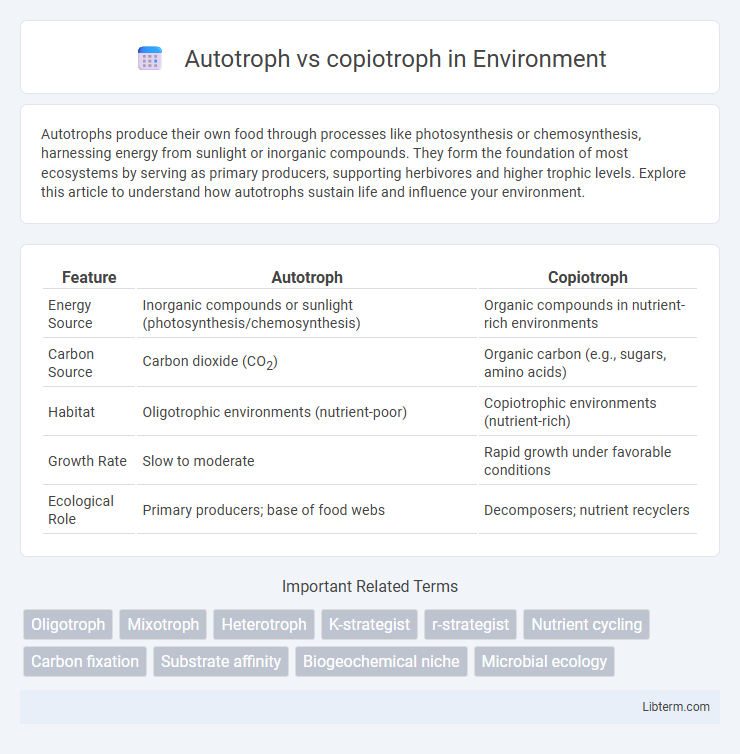Autotrophs produce their own food through processes like photosynthesis or chemosynthesis, harnessing energy from sunlight or inorganic compounds. They form the foundation of most ecosystems by serving as primary producers, supporting herbivores and higher trophic levels. Explore this article to understand how autotrophs sustain life and influence your environment.
Table of Comparison
| Feature | Autotroph | Copiotroph |
|---|---|---|
| Energy Source | Inorganic compounds or sunlight (photosynthesis/chemosynthesis) | Organic compounds in nutrient-rich environments |
| Carbon Source | Carbon dioxide (CO2) | Organic carbon (e.g., sugars, amino acids) |
| Habitat | Oligotrophic environments (nutrient-poor) | Copiotrophic environments (nutrient-rich) |
| Growth Rate | Slow to moderate | Rapid growth under favorable conditions |
| Ecological Role | Primary producers; base of food webs | Decomposers; nutrient recyclers |
Introduction to Autotrophs and Copiotrophs
Autotrophs are organisms capable of producing their own energy through photosynthesis or chemosynthesis by converting inorganic substances into organic compounds, making them essential primary producers in ecosystems. Copiotrophs thrive in nutrient-rich environments, rapidly consuming available organic matter, and are often found in environments with abundant resources such as agricultural soils or wastewater. Understanding the metabolic strategies of autotrophs and copiotrophs reveals their distinct ecological roles in nutrient cycling and energy flow.
Defining Autotrophs: Energy and Carbon Sources
Autotrophs are organisms that utilize inorganic carbon sources, primarily carbon dioxide, to synthesize their own organic compounds through processes like photosynthesis or chemosynthesis. Their energy is derived from light (photoautotrophs) or inorganic chemical reactions (chemoautotrophs), enabling independence from organic carbon sources. Unlike copiotrophs, which rely on abundant organic nutrients, autotrophs play a crucial role in primary production and carbon fixation in ecosystems.
Defining Copiotrophs: Nutrient Preferences and Growth
Copiotrophs are microorganisms characterized by rapid growth rates and a preference for nutrient-rich environments, often thriving in habitats with abundant organic carbon and nitrogen sources. They contrast autotrophs, which synthesize their own food from inorganic sources and usually grow slower under limited nutrients. Understanding copiotrophs' nutrient preferences is essential for studying microbial ecology, especially in soil and aquatic systems where nutrient dynamics influence population dynamics.
Key Differences Between Autotrophs and Copiotrophs
Autotrophs are organisms that synthesize their own organic molecules from inorganic carbon sources, primarily through photosynthesis or chemosynthesis, sustaining themselves without external organic nutrients. Copiotrophs are microbes adapted to environments rich in organic nutrients, characterized by rapid growth and high metabolic rates when organic carbon is abundant. The key differences lie in their carbon acquisition strategies--autotrophs fix carbon dioxide to produce biomass, whereas copiotrophs rely on readily available organic compounds for energy and growth.
Ecological Roles of Autotrophs
Autotrophs play a crucial ecological role by synthesizing organic compounds from inorganic sources through photosynthesis or chemosynthesis, forming the base of most food webs. They contribute significantly to carbon fixation, supporting energy flow and nutrient cycling in ecosystems, especially in terrestrial and aquatic environments. Their ability to produce biomass without relying on organic substances makes them fundamental in sustaining heterotrophic organisms like copiotrophs, which depend on readily available organic nutrients.
Ecological Roles of Copiotrophs
Copiotrophs play a crucial ecological role by rapidly utilizing abundant nutrients in environments with high organic matter, such as nutrient-rich soils and aquatic systems. They contribute significantly to carbon cycling and nutrient turnover by decomposing organic material and facilitating the release of nutrients for other organisms. Their fast growth and high metabolic rates enable copiotrophs to dominate microbial communities during nutrient pulses, influencing ecosystem productivity and stability.
Environmental Conditions Favoring Autotrophs
Autotrophs thrive in environments with abundant inorganic carbon sources, such as carbon dioxide, and ample sunlight or chemical energy for photosynthesis or chemosynthesis. They dominate in nutrient-poor, stable ecosystems where organic nutrients are limited. These conditions contrast with copiotrophs, which prefer nutrient-rich habitats with high organic carbon availability.
Environments Where Copiotrophs Thrive
Copiotrophs thrive in nutrient-rich environments such as soils with abundant organic matter, wastewater treatment plants, and eutrophic aquatic systems. These bacteria rapidly consume available substrates and grow quickly due to their high metabolic rates and ability to utilize diverse carbon sources. In contrast, autotrophs dominate in nutrient-poor or oligotrophic conditions by synthesizing organic compounds from inorganic sources like carbon dioxide.
Importance in Biogeochemical Cycles
Autotrophs drive biogeochemical cycles by converting inorganic carbon into organic matter through photosynthesis or chemosynthesis, forming the base of most ecosystems' food webs. Copiotrophs influence nutrient cycling by rapidly decomposing organic matter in nutrient-rich environments, accelerating carbon and nitrogen turnover. Their complementary roles regulate ecosystem productivity and maintain soil fertility, crucial for sustaining biodiversity and biogeochemical stability.
Autotrophs vs Copiotrophs: Implications for Biotechnology and Environmental Management
Autotrophs, which synthesize organic compounds from inorganic sources using light or chemical energy, play a pivotal role in carbon fixation and bioenergy production, offering sustainable solutions in biotechnology. Copiotrophs thrive in nutrient-rich environments, rapidly decomposing organic matter and influencing nutrient cycling, making them crucial for effective wastewater treatment and soil remediation strategies. Understanding the metabolic pathways and ecological roles of autotrophs versus copiotrophs enhances biotechnological applications and informs environmental management practices aimed at ecosystem restoration and pollution control.
Autotroph Infographic

 libterm.com
libterm.com